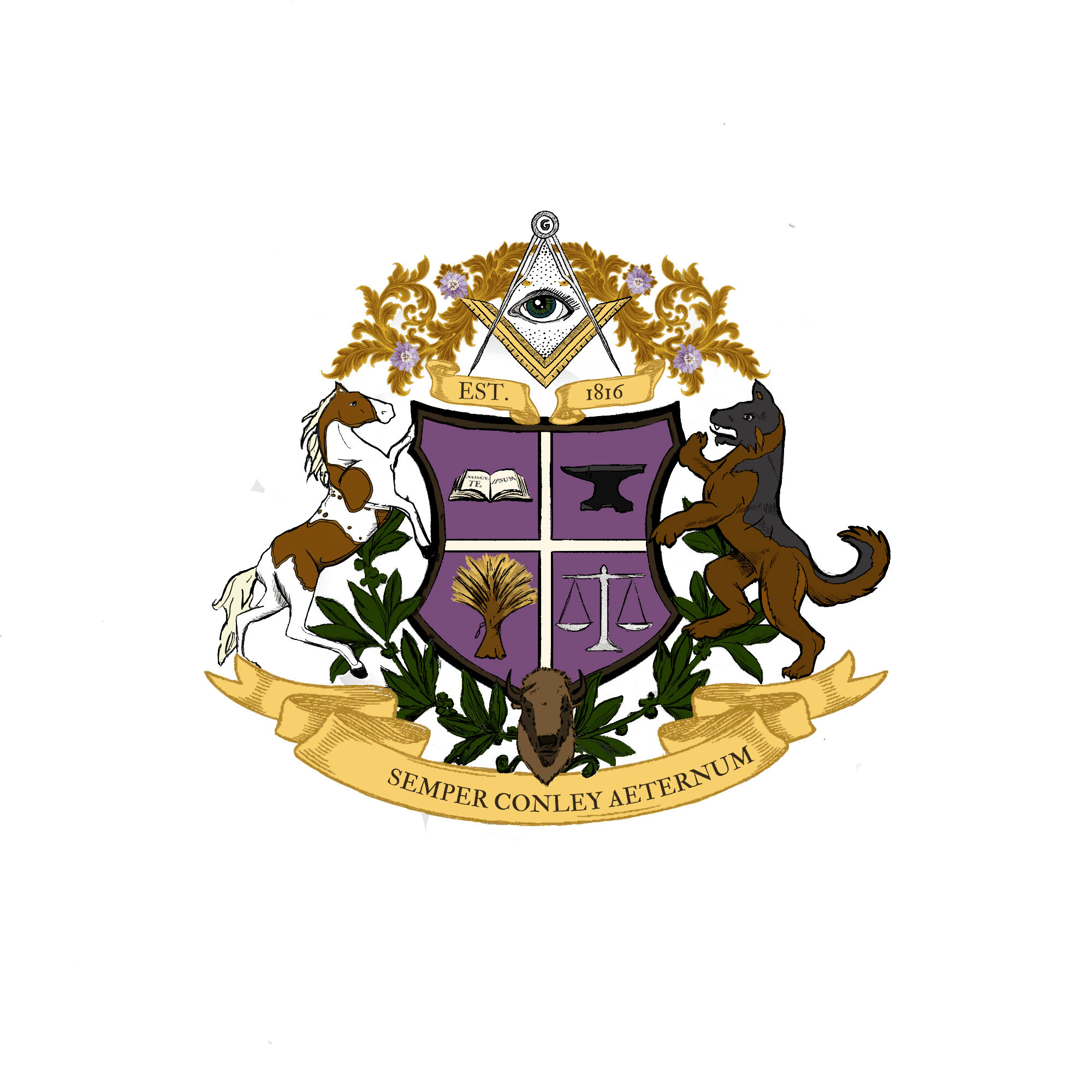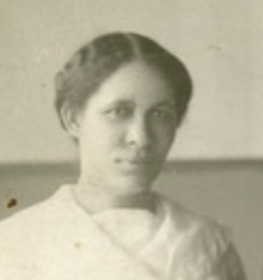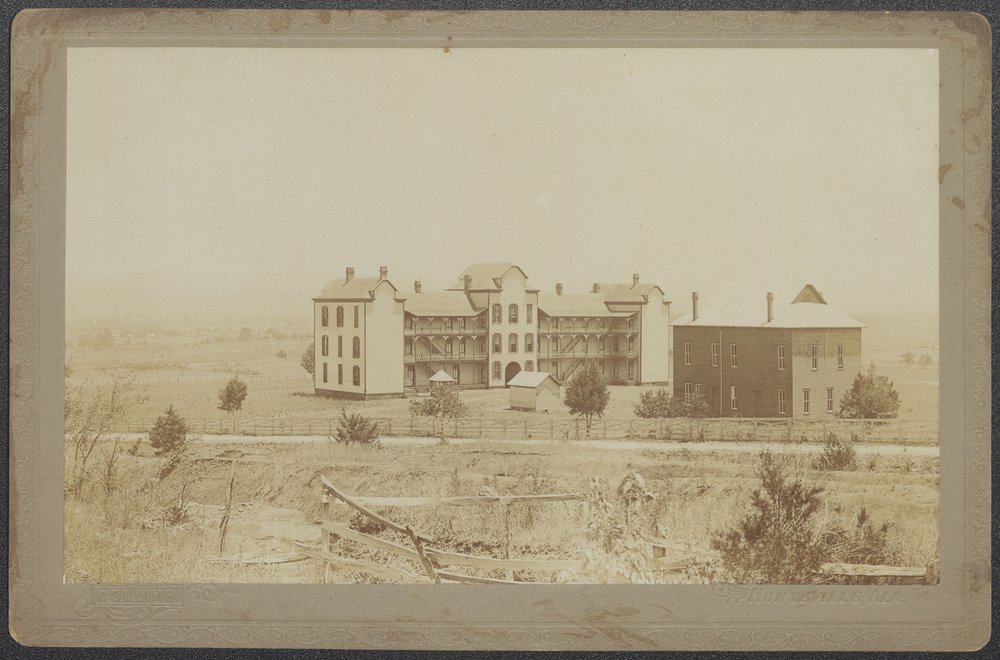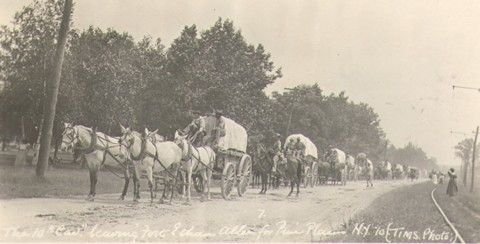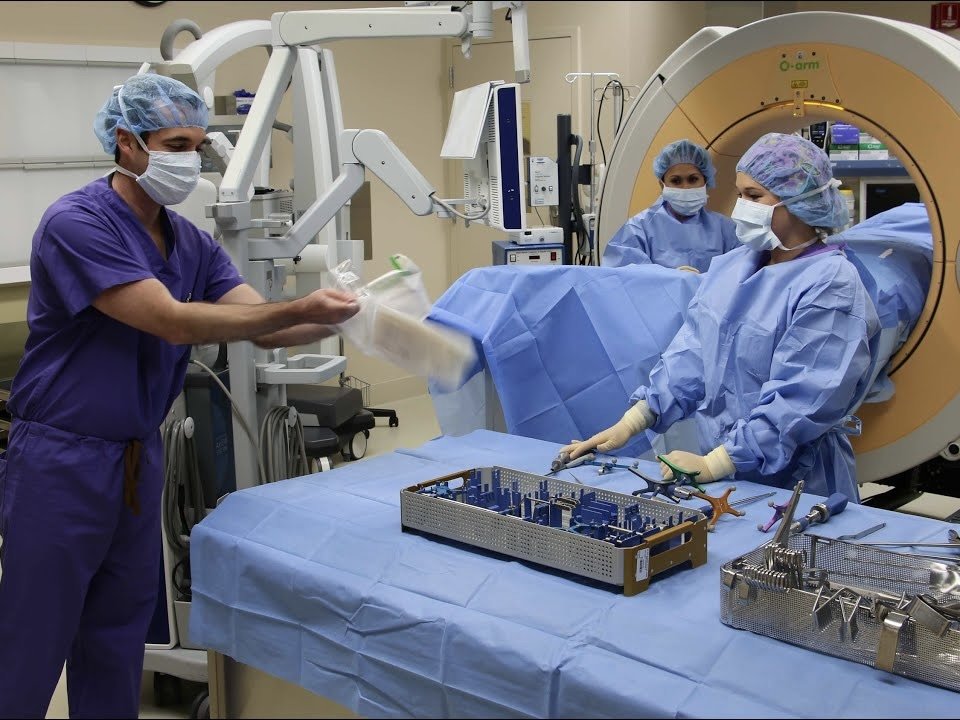SALLIE CONLEY THORNTON
Sallie Ann Conley Thornton is an iconic figure of the Conley Family’s 125-year legacy in nursing. She was also the start of our nursing tradition with her service in the predecessor organization to the Army Nurse Corps in 1898 as the Spanish-American War began. Today, our sixth generations of nurses, doctors, and medical science professionals are stronger than ever.
The Sallie Conley Family, circa 1912. Listed with relation to Sallie. (Left to Right sitting): Edgar Paschal Scruggs grandson; Ellen Maude Scruggs, granddaughter; Sallie Ann Conley Thornton, center with yellow halo; Beverly Thornton, husband; Thornton Zann Scruggs, grandson; Louis "Louie" Hollis Scruggs. (Left to Right Standing): Zan Scruggs, son-in-law; Jessie Lee Conley Scruggs, daughter; Margaret Eunice Scruggs, daughter; Levi Burgess Scruggs; unidentified woman; Mary Steiger Conley, mother to Sallie.
Sallie Ann Conley. Courtesy of Michael Proulx.
Before she was born, Sallie’s father, aunts and uncles had held various roles at a nearby equestrian sporting resort, where the wealthy enjoyed steeple chase, flat racing, carriage riding and other horse events.
SALLIE ANN CONLEY THORNTON (1864-1931)
Sallie Ann Conley Thornton was born in 1864 in Huntsville, Alabama to Paschal Conley Sr. & Mary Steiger Conley. Her father, Paschal Conley Sr. was trained as a groom (stable hand) as a child at the famous Green Bottom Inn & Equestrian Sporting Center. As an adult, he became a prosperous livery and stable owner in the years after the Civil War, leveraging the legend of his father James, and grandfather.
The success of her father’s livery operation and stables after the Civil War meant Sallie’s family enjoyed a comfortable, though precarious, elevation in the strange social hierarchy of The South.
Paschal Conley Sr. & Mary Steiger Conley, parents of Sallie Ann Conley Thornton. Restored sketch believed to have been drawn by sign painter Felix Conley, brother to Paschal Sr.
Original entrance to the Green Bottom Inn & Equestrian Resort. Sallie’s grandfather was the valet and carriage driver for his father, John Connally. Sallie’s father was trained in livery operations the failed horse stables there.
1865-1880 - EARLY YEARS
Paschal Conley Sr. Livery & Stable operator.
Paschal Conley had a stable in downtown Huntsville, and other businesses with his brothers. He shared a building with his business partner Levi Scruggs, a popular Colored barber to the wealthy whites in town.
Sallie enjoyed a relatively privileged youth, common among the artisan class of ‘Free Coloreds’ in towns throughout the South. Each small town had them: a small group of families, usually of mixed race, who were trained by newly arrived European indentured servants to work for landowning whites. The ‘Colored’ men were trained in craftsman vocations like metal smithing, stone masonry, carpentry, woodworking, carriage making, gardening, barbering, and veterinarian roles. The ‘Colored’ women were often trained as bakers, pottery, weaving, hairdressers, maids, and seamstresses. From about 1600 to 1900, these artisan Coloreds served the needs of wealthy whites seeking to mimic the lifestyles of European landed gentry.
Sallies’s father Paschal Sr., was the first Colored benefactor of William H. Councill, helping to establish the Lincoln School in 1869, the precursor to Alabama A&M University. The Lincoln School, which was private, became the Huntsville State Normal School for Negroes (1875–1885) with money from the Federal Government, which gave way to the State Normal and Industrial School of Huntsville (1885–1896) funded by Alabama, which evolved yet again into The State Agricultural and Mechanical College for Negroes (1896–1919). After World War I, the school change names and directions again, become the State Agricultural and Mechanical Institute for Negroes (1919–1948). After World War II, the school harnessed the post World War II boom by becoming the modern day Alabama A&M College (1948–present) that we know today.
The Lincoln School provided Sallie with a basic education until she was 12, at which time she attended Huntsville State Normal School for Negroes until 1879. As was the norm in 1880, Sallie married as soon as a suitable husband presented himself. In this case, Sallie met and married John Scott. From the this marriage a daughter Jessie Lee was born. We do not know the circumstances of John Scott’s death, but we do know that Sallie became a very young widow not long after the marriage.
1880-1898 - COMING OF AGE IN HUNTSVILLE
Sallie registered to become a nurse at her brother’s suggestion. She resumed her education briefly at the Huntsville Academy, where she received basic nurse training at the start of the Spanish-American War. When Sallie began her service in 1898, women of Asian and African ancestry were thought to be immune from Malaria, Yellow Fever, and other tropical viruses. Sallie would go on to serve as a military nurse from 1898 until 1908.
Sallie Conley was one of the original Contract Nurses who supported the U.S. Army during the Spanish-American War of 1898. More than 1,500 women nurses worked as contract nurses during the Spanish-American War and subsequent military occupation of Cuba, the Philippines, and Puerto Rico.
As part of the contract nurse initiative, the U.S. Army recruited 32 ‘immune’ nurses of with varying levels of African, Asian, or Native American ancestry, many of whom were immediately sent to Cuba. Sallie was one of the next wave of about 100 "immune" nurses.
The valor of these Women of Color led to the formation of the Army Nurse Corps (ANC) in 1901. However, the same women of African, Asian, and Spanish ancestry who created the Nurse Corps could not legally join the ANC until 1947.
Huntsville Academy was located in Huntsville, Alabama and was used as the Second District Hospital from October 15, 1898 to February 8, 1899. During its use as the Second District Hospital, many nurses assembled here before leaving for Cuba. Photo credit: The U.S. Military Women's Memorial - Exhibits
1899-1909 WAR AND WORLD TRAVEL
Sallie Ann Conley Thornton and 2nd husband Beverly Thornton. Photo courtesy of Diane Gregg Morin, 3x-great-granddaughter of Sallie Conley Thornton.
After her deployment in Cuba and the Philippines, Sallie was assigned to Fort Robinson in Nebraska, where her brother Quartermaster Paschal Conley was also stationed. He had been a member of the original 24th Calvary Company ‘B’ and rose to prominence with his service in the celebrated 10th Calvary, Troop ‘M’ under the legendary General John J. Pershing. Her brother Paschal was a leader on military bases across the American West, and facilitated reading and sports activities for the troops.
Paschal’s best friend and aide-de-camp was Beverly Thornton, a highly educated widower, upon whom Paschal relied greatly. Beverly was graduate of Hampton University Class of 1882, and helped bring Paschal’s vision of poet-warriors to life.
An erudite and scholarly personality, his patriotism was evident as he wrote in the Hampton Alumni Bulletin in 1893, “I’m going to stand by my country, no matter how great the danger.”
Beverly suffered tragedy early in his adult life when his first wife and daughter died of sudden illness. Paschal paired his widower friend, and his widowed sister. It was Paschal’s suggestion that Beverly consider marrying his widowed sister Sallie. In 1904, at age 42, Sallie married Beverly Thornton at Fort Robinson in Nebraska.
Nearing the end of his career Paschal Jr. also secured key military roles for his sons, Charles and Edward. He also found military roles for his sister Fanny Conley Nemo’s children, and for his nephews who were Sallie’s grandsons. In 1906, Paschal Conley Jr. retired and settled into a new life in Montana, amassing considerable real estate holdings. A dutiful patriarch, Paschal secured the future.
1910-1915 Vermont
Sallie and her husband Beverly spent 1907 to 1909 deployed with the occupation forces in the Philippines. According to historian David Work of Texas A&M, “… in May 1909 [the 10th Calvary] boarded ship to return to the United States. The journey took two and a half months as the regiment sailed west by way of Singapore, Ceylon, Saudi Arabia, the Suez Canal, Malta, and Gibraltar. On July 25, the Tenth arrived in New York City where it was greeted by the greatest public demonstrations any Buffalo Soldier regiment ever received.”
The New York Times reported on July 26, 1909, that a large crowd of greeting the troops upon their arrival at the peer now known as South Street Seaport. The next day the 10th Calvary was treated to a ticker tape parade, which proceeded up Wall Street from present-day South Street Seaport, then north on Broadway, ending at City Hall Park. The remarkable day ended with a banquet. The following morning the 10th Cavalry proceeded to its new post, Fort Ethan Allen, Vermont.
It was at this apex of her social prestige with the Buffalo Soldiers that she joined her husband Beverly as the 10th Calvary made their way up to New England, arriving in Vermont on July 28, 1909.
Sallie Conley Thornton arriving in Burlington, Vermont with the other families of the 10th Calvary in July 1909. Her wagon leads the line as the senior family. Photo credit: New York Times July, 1909.
Buffalo Soldiers exhibition parade in New York City July 1909.
As a senior member of the Buffalo Solider community, and as the sister of 2nd Lt. Paschal Conley Jr., Sallie and Beverly Thornton became leaders at Fort Ethan Allen.
The 10th Calvary arriving in Vermont for duty at Fort Ethan Allen, July 1909. Photo credit: New York Times, July 1909.
In 1915, when the Buffalo Soldiers finished their four-year stay, and were reassigned to a new fort in Arizona, Beverly Thornton retired. He and Sallie remained in Vermont with four other Buffalo Soldier Families. All of the remaining families integrated into the community of Greater Burlington. Sallie acquired a generous plot of land and built a family compound with homes for Sallie’s daughter Jessie Lee, her husband Zan Scruggs, and their seven children.
1915-1930 THE LAST CHAPTER
Four (4) generations of Conley women at the compound in Vermont circa 1930. Jessie Lee Scruggs (standing on left), Margaret Scruggs Vannah (sitting with baby daughter Phyllis Vannah on lap), Sallie Conley Thornton (standing on right)
Photo courtesy of Michael Proulx, Conley Family historian.
THE CONLEY COMPOUND IN VERMONT WITH ENTRANCE MARKED BY THORNTON STREET NAMED FOR BEVERLY AND SALLIE THORNTON.
The Conley Family were generally a pastoral people, preferring a country lifestyle, often in the hills or forests. They tended to live in compounds with family homes clustered together on a large property. When Sallie Conley Thornton and husband Beverly built the Conley Compound in Vermont, the outskirts of Burlington were rugged rolling hills. While Sallie’s descendants migrated to California and Maine, the family compound remains in tact, with the homes that were occupied by various family members still in place.
THE LEGACY OF SALLIE CONLEY THORNTON
Seated: Mary Steiger Conley, mother of Sallie Conley Thornton with her granddaughter Margaret Scruggs Vannah. Photo courtesy of Michael Proulx, 2x-great-grandson of Margaret Scruggs, and 4x-great-grandson of Mary Steiger Conley.
The Sisters Vannah: Great-Granddaughters of Sallie Conley Thornton, granddaughters of Jessie Lee Conley Scruggs, daughters of Margaret Scruggs Vannah. The foundation of the Conley Family in Maine.
Standing, left to right: Barbara, Phyllis, Marion, Shirley. Seated: Lorraine. Photo Courtesy of Diane Gregg Morin, Conley Family Historian. Diane’s mother Shirley sitting on far right.
INCLUSION:
Sallie Ann Conley Thornton left an extraordinary legacy of inclusion. Every Conley, whether self-identifying as Asian, Black, Latino, or White owes debt to Sallie.
It’s Conley First, Conley Forever, and Forever a Conley.
Sallie was one of the many Conleys who chose to maintain the family’s value system that emphasized family cohesion above racial categorization.
Both four of Sallie’s seven grandchildren would marry local New England WASP families, continuing the Conley Family’s multicultural embrace of the American Dream.
THE FINANCIAL LEGACY OF SALLIE CONLEY THORNTON
Sallie Conley Thornton was a model of self-reliance, and a pioneer in women’s finance. From a young age, Sallie showed a talent for managing money. As a young widow, Sallie was fortunate to have the financial support of her parents, Paschal Sr. & Mary Steiger Conley, and lived with them while raising Jessie Lee.
There was never one great Conley fortune, and no single trust fund supporting multiple generations. From the Original Conley Brothers, each family member was expected to make their own way in the world, but to cooperate and collaborate with family members whenever possible. The Conley were especially savvy in managing wealth, but very discreet.
An original insurance policy owned by Sallie Conley Thornton, dated May 1, 1899. Image Courtesy of Diane Gregg Morin.
INSURANCE
Sallie used insurance policies to circumvent legal barriers to women owning assets. In 1898, she obtained multiple insurance policies, which named her daughter as the beneficiary. Like the Rockefellers, she used insurance as an asset. Only a handful of women, regardless of ethnicity, held such insurance policies before 1920.
BANKING
Sallie was an original member of an early form of credit union, called the The Independent Order of Immaculates (or IOI). It offered Colored Women financial products like bank accounts, life insurance, and health insurance without the co-signature of a man. Sallie and other Conley women appeared to have helped establish the Huntsville Lodge similar to what we know call a ‘branch office’. Sallie was shrewd.
The meeting minutes of the meeting of The Independent Order of Immaculates (or IOI) at whichSallie may have helped establish the Huntsville Lodge (Branch).
NAOMI DICKERSON - ATHLETE & NURSE
Naomi is the third-great-granddaughter of Sallie Ann Conley Thornton. Born and raised in California, she embodies two traditions: sports and healthcare.
A former NCAA college softball player player for Georgia Tech, she is the best of the scholar-athlete tradition started by her third-great uncle Levi Burgess Scruggs as a football player for University of Vermont in 1922.
After her graduation from the Georgia Institute of Technology with a bachelor's degree in Business Administration, she was trained in nursing at Marian University. Naomi studied bone health with a focus on the connection between exercise and osteoporosis. She is currently a nurse in Nashville, Tennessee, carrying forward the Conley tradition in healthcare.
Naomi Dickerson, Georgia Tech women’s softball. Naomi played NCAA Division I level, her college career interrupted by the global pandemic of 2020-2022. Photo credit: Georgia Tech Athletic Dept.
Naomi in action on the pitching mound at Georgia Tech, 2020. Photo credit: Georgia Tech Athletic Dept.
Naomi began training as a nurse at Marian University in Nashville, Tennessee. Photo credit: Marian University, accessed 2023.
Photo credit: Marian University, accessed 2023.
